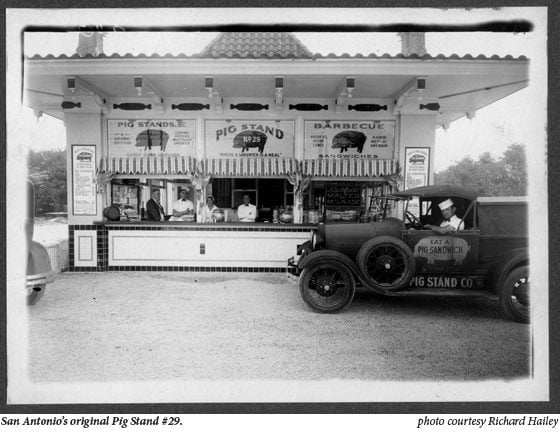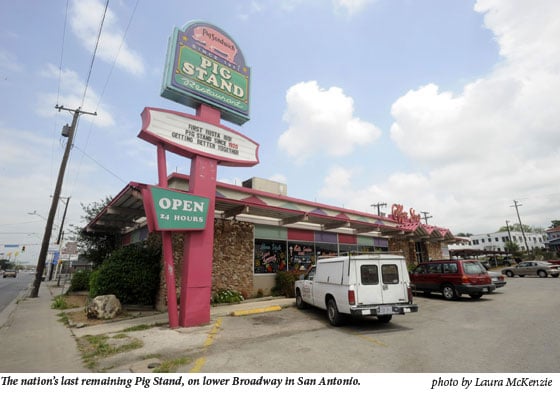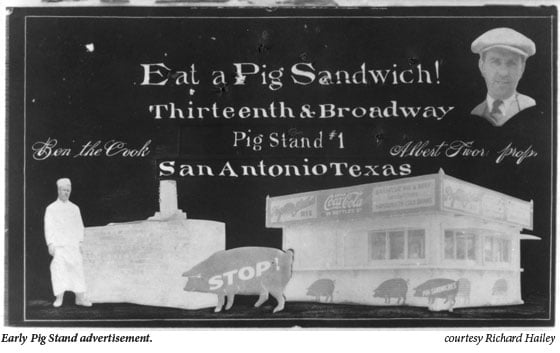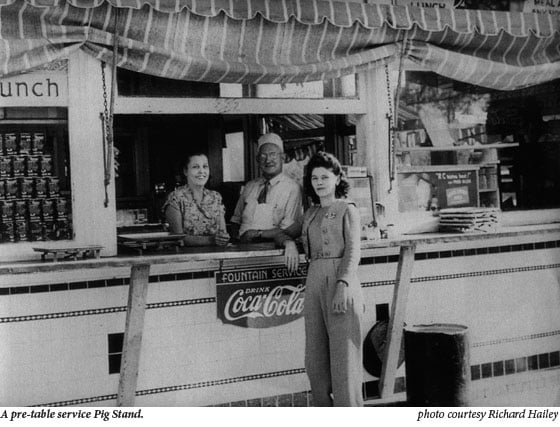
Last Pig Standing
In San Antonio, Texas' founding contribution to fast-food culture hangs on by the hair of its chinny chin chin.
With her adult son in tow, Alexa Lagunas returned to the faded old Pig Stand restaurant on lower Broadway in San Antonio recently, looking for a familiar plate of fish and chips, a milk shake, and some sweet echoes of days gone by.
“I come back for the memories. On a Friday night, it was always a big crowd of people. The place was like a magnet,” says Lagunas, 57, who was raised a few blocks away.
“It makes me think of all the good times I had when I was growing up, how we all enjoyed it,” she says. “There were lots of teenagers, everyone friendly, and the car-hopping was going big-time.”
In one sense, time stopped in 1963 at this uniquely Texan gastronomical shrine, the last of the fabled Pig Stand restaurants, where the celebration of old cars, vintage rock and roll, and throwback fare like pork sandwiches never dies.
Tom Waits would be right at home here, slouching in a red vinyl booth after midnight amid the cops, weary late-night celebrants, and wrecker drivers, all there for a greasy bite.
At the Pig Stand today, nostalgia rules without apology. Oldies giants like Buddy Holly, The Beach Boys, and The Kingsmen are still going strong on the box, and culinary standards like the Pig Sandwich and the Black Cow-as root beer floats are known to insiders-are still on the menu.
For misplaced health nuts, there’s a seasoned pork loin salad. The interior décor is heavily larded with porcine kitsch.
In one corner is a half-century-old Coke machine offering nickel sodas. On the walls, antique photos of Pig Stands long forgotten share space with lush depictions of classic T-birds and Caddies.
Close your eyes and John F. Kennedy is still in the White House. In the dining room, a life-size Elvis cutout, slim and saucy in a sparkling white suit, tosses a lopsided grin. Down a hallway, a sultry-eyed Marilyn is still smoking hot in a sleeveless black gown.
“It just sort of represents the whole Texas drive-in experience. It goes way back to the 1920s, and they once had them in a lot of places,” says Michael Karl Witzel, author of The American Drive-In.
Once a magnet for cruising teenagers and hot-rodders, the last Pig Stand on Earth still draws the crankshaft crowd on occasional Friday nights, when they gather in the parking lot to ogle each other’s restored babies.

A customized red ’46 Dodge pickup, complete with a 302 Ford engine and Mercedes radiator, was recently posted for sale beside the front door. Offers welcome.
For generations of urban Texans, the Pig was an integral part of coming of age, becoming entwined with the state’s cultural DNA.
“We’ve had people who met here, had their first date here, and 50 years later they come back on their anniversary,” says Mary Ann Hill, 59, the longtime manager, who began waiting tables when LBJ was bombing North Vietnam.
No less a Texan than author Larry McMurtry chose Houston’s iconic Washington Avenue Pig Stand to set parts of his novel The Evening Star.
Scenes in the subsequent movie starring Jack Nicholson and Shirley MacLaine were filmed there.
In the book, the female lead character, Aurora Greenway-played in the film by MacLaine-showed an appetite for pig sandwiches that would humble a sumo wrestler.
In one scene, Greenway eats three of the hefty sandwiches, followed by pie and ice cream. Despite this wanton gluttony, she was clearly not your typical Pig Stand diner, according to the book.
“The customers of the Pig Stand, a typical assortment of human flotsam and jetsam, most of them possessed of a fatigue not yet quite emptied of curiosity, merely wondered why Aurora, a woman who looked like she had enough money to eat elsewhere, kept showing up at the Pig Stand,” McMurtry wrote.
Modern times have been unkind to the once-mighty home of the neon pig. The restaurant where MacLaine gorged in Houston is shuttered and unlikely to reopen. The same goes for a circular version of the restaurant in Beaumont.
Almost nine decades after the chain was born, only one Pig Stand remains, old No. 29 on Broadway in San Antonio. In its faded, pastel glory, it lingers like the last of an ancient species, rescued from the limbo of bankruptcy court, crouched below the interstate.

The year was 1921, and America was crazy for bathtub gin, hot jazz, and Henry Ford’s Tin Lizzie, which sold a million that year and ruled the roads.
In North Texas, two far-sighted entrepreneurs opened a modest eatery on the busy Dallas-Fort Worth Turnpike that would change the way Americans ate.
Upsetting convention, their tiny “Pig Stand” had no dining room. Instead, it offered speedy curb service to hungry motorists, allowing them to grab a quick bite behind the wheel.
“People with cars are so lazy, they don’t want to get out of them,” was the sentiment attributed to Jessie G. Kirby, one of the Pig Stand founders.
The somewhat unflattering insight rang true.
The Pig Stand’s slogan was “America’s Motor Lunch,” and as motorists arrived, teenage carhops in white shirts and black bow ties leaped onto running boards to take orders.
The fare, including barbecued pork sandwiches and milk shakes, was hustled back to curbside. The dine-behind-the-wheel concept was an instant hit.
Thus was born the American drive-in restaurant. In marrying the country’s growing infatuation with the automobile to its hunger for a quick, portable meal, the Pig Stands changed the popular notion of what it means to eat out.
It also created the template for the modern, fast-food restaurant, making early use of air-conditioning, fluorescent lighting, and standardization.
“It was an early, pioneering effort to bring fast food to the motorist. As the first drive-in, it introduced a lot of new elements that later became popular,” says historian Dwayne Jones, now executive director of the Galveston Historical Foundation.
“They really started it: the image building. The use of the pig. The use of neon. And very quickly, they adopted a corporate building form, the pagoda, which would be the image of the Pig Stand for the next 20 years,” says Jones, who has written a brief history of the chain.
Along the way, the Pig Stand introduced such gastronomical innovations to the national menu as Texas toast, deep-fried onion rings, and a regional tour de force: the chicken-fried steak sandwich.

Within a decade, the neon silhouette of a rotund lounging pig could be seen roadside from coast to coast. When the chain reached its peak in the 1930s, about 130 Pig Stands were in operation, most of them in Texas and California.
By then the company began to offer full-service dining, and sometime between the Great Depression and the onset of World War II, the chain’s popularity crested.
A long, slow decline began with wartime rationing of gasoline and other supplies. Many restaurants were sold to employees, and by the end of the 1950s, there were no Pig Stands to be found outside of Texas.
By 2005, only six remained statewide, with two in San Antonio and one each in Houston, Beaumont, Lytle, and Seguin. All were owned by Richard Hailey, the son of Royce Hailey, a former Pig Stand carhop who had risen through the ranks to own the chain.
The younger Hailey had recently opened the Seguin Pig Stand and bought another restaurant in San Antonio, and the expansion proved fatal.
By mid-2005, Hailey had filed both corporate and personal bankruptcy, with Texas Pig Stands listing $1.8 million in liabilities.
For Hailey, it was a bitter personal tragedy.
“It’s been pretty much my whole life to this point. I’ve always felt the responsibility, and was honored to carry on the history and my father’s legacy,” he says.
“I’m real proud of the job I did,” he adds. “I was always proud of the significance the Pig Stands had in people’s lives. I’m disappointed it ended the way it did.”
Because Pig Stands inspire extreme loyalty among customers and employees, the closures have been traumatic. For some, the idea of a world with no Pig Stand is unthinkable.
“I live in Alamo Heights, but come down here every day to eat my breakfast. I spend a couple of hours a day here every day of the week,” says Gene Olson, 72, a U.S. Postal Service retiree who has been eating there for 35 years.
“If anything happens to me, my daughter would call them. I’ve instructed her to call here,” he says. “We’d lose a piece of San Antonio if it were to close. For me, it would be devastating.”
At No. 29, employees and customers go back years, even decades together.
“I know all of them. I already know what they are going to order, and I start cooking it before I even get their order,” says Dave Rocha, 40, a Pig Stand cook with a wispy reddish beard and a pea-sized diamond in his left ear.
“This guy right here, he always eats his sausage and gravy. And that man over there eats two eggs over easy with hash browns, and he comes in every day, too,” he says, gesturing to a couple of old-timers having breakfast in adjacent booths.
“People come here because it’s an old restaurant, it’s an historic place, and they can get homemade food here,” says Rocha, a relative newcomer whose Pig Stand tenure goes back only to 1995.

Waitress Irela Bustamante has clocked uncounted miles over the black and white linoleum tiles during her 33 years here, hauling plates to familiar faces. By her own rough count, she’s served a quarter-million breakfasts.
“I’ve been devoted to my job my whole life. I never missed unless I was sick, and maybe five times I’ve come in late,” she says.
When she started, curb service was still available, and girls on roller skates still delivered food to motorists waiting under the outdoor canopy.
“We used to carry the food on little trays, kind of like Sonic, and put them on the windows,” she says.
In years since, the Pig Stand became a dine-in eatery except on Friday nights, when curb service was restored for the hot-rodders who jammed the parking lot.
When No. 29 temporarily closed in late 2006, Bustamante was stricken, and not just over the loss of her job. The relationships that begin here can carry well beyond the restaurant.
“I was afraid it was over,” Bustamante says.
Manager Hill adds, “It’s not just serving the people. It’s getting to know them. In my 42 years here, I’ve had five people call me just before they died and thank me for being their waitress and serving them.”
Hill recalls the extraordinary measures taken about three years ago when one regular stopped showing up.
“Do you remember Bob?” Hill asks another veteran employee. “He sat at the end of the counter.”
“He missed two days. Laurie said, ‘I can get into his apartment,’ so we sent her over, and sure enough, he was down, and he was taken to the hospital,” she says.
Bob never made it back to the Pig Stand, but at least he didn’t die alone in his apartment.

By the time the Pig Stand on South Presa Street in San Antonio closed in late 2006, manager Julie Clifton had worked 30 years for the company. Even after the bankruptcy in 2005, she had hopes the chain might survive.
That possibility died in late 2006, when agents for the state comptroller’s office showed up to collect unpaid sales taxes during lunch hour. Two weeks later, the Pig Stand on Presa was closed for good.
“One day they just came in and took all the money out of the register. It was humiliating. I was broken-hearted,” Clifton says. “Then about two weeks later, Mr. Hailey called me and told me to lock all the doors before midnight, before the next crew came on. We took all the money and told everyone to go home.”
That the Broadway Pig Stand emerged from bankruptcy and survives today is the chain’s only good-news story in years.
That outpost reopened in early 2007 after a six-week shutdown when bankruptcy trustee Vincent Liuzza Jr. cut a creative deal involving Hill and Marie Hernandez, the longtime landlord whose husband Pete had been devoted to the Pig Stand.
Of all the long-tenured Pig Stand employees, 59-year-old Hill ranked first, and it’s appropriate that she became its savior.
“I came on as a waitress in 1967. I was 18, and this is the only job I’ve ever had, and it’s been a wonderful job,” she says.
Soon after the restaurant closed, Liuzza told Hill that if she could raise enough money to bring the lease current and pay off delinquent property taxes, she could reopen the business.
“He told me it would be about $10,000, but that was way off,” Hill recalls. “The [property] taxes hadn’t been paid in three years, and the lease hadn’t been paid in three months. Plus, I had to buy groceries. It took almost $50,000, and I’m still paying that off.”
In January 2007, old No. 29 was reopened as Mary Ann’s Pig Stand.
For Hailey, 59, who was literally born into the world of the neon pig, and then spent most of his life promoting and operating Pig Stands, this is the only consolation left.
“It makes me extremely happy to see it open. I’m happy Mary got the opportunity, and I feel like she’s on solid ground,” he says of his former employee.
“I still go by there often, talk to her and get a cup of coffee. It still feels like home,” he says. “I see the regular customers, and I talk to them.”
Though the Broadway Pig Stand is up and running, the long-term business arrangements are uncertain.
Hill is leasing the business from a trust created by the bankruptcy court, but the trust will likely be dissolved long before Hill’s 10-year lease expires.Liuzza says he is still trying to figure out an arrangement that will allow her to own the business outright.
“I need to come up with some agreement and get the court to bless it,” he says.
Once on the cutting edge of restaurant style and technology, the last Pig Stand is now a doddering, if beloved, symbol of old times.
While modernity nearly killed it, the Pig Stand is still treasured by those who never lost their cravings for pork sandwiches, root beer floats, and fond memories of youth.
And don’t start writing its obituary yet.
Crazy as it sounds, the once-mighty, pioneering chain could make a comeback if the right pieces fall into place, according to Liuzza, the trustee.
“I grew up in the restaurant business, and this is a real unique thing. It has a lot more value than the numbers we’re talking about today if someone can use the history,” Liuzza says.
“I believe there is some restaurant company that will pay several million dollars for the brand. They could build a chain on that name and be the oldest drive-in in the world,” he says.
Then, perhaps, this pig could truly fly.
Occasional Pig Stand patron John MacCormack has worked as a reporter in San Antonio for more than two decades.


